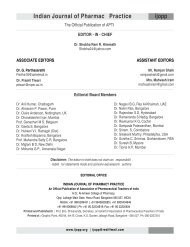Jul-Sep, 2012 - Indian Journal of Pharmacy Practice
Jul-Sep, 2012 - Indian Journal of Pharmacy Practice
Jul-Sep, 2012 - Indian Journal of Pharmacy Practice
Create successful ePaper yourself
Turn your PDF publications into a flip-book with our unique Google optimized e-Paper software.
<strong>Indian</strong> <strong>Journal</strong> <strong>of</strong> <strong>Pharmacy</strong> <strong>Practice</strong>Association <strong>of</strong> Pharmaceutical Teachers <strong>of</strong> IndiaComparison <strong>of</strong> days lost due to disability and Karn<strong>of</strong>sky performance status in burden <strong>of</strong>dicl<strong>of</strong>enac induced adverse drug reactions1 2 3Thomas D* , Mathew M and Mahendra Kumar B.J1Head, Dept <strong>of</strong> <strong>Pharmacy</strong> <strong>Practice</strong>, RIPER, A.P., India2Principal, Malik Deenar College <strong>of</strong> <strong>Pharmacy</strong>, Kasaragod, Kerala, India3Pr<strong>of</strong> & Head, Dept <strong>of</strong> <strong>Pharmacy</strong> <strong>Practice</strong>, Director PG Studies, JDT Islam College <strong>of</strong> <strong>Pharmacy</strong>, Kozhikode, Kerala, IndiaA B S T R A C TSubmitted: 24/08/<strong>2012</strong>Accepted: 12/09/<strong>2012</strong>Basic objective <strong>of</strong> this study was to find out the benefit <strong>of</strong> Days Lost due to Disability (DLD) over Karn<strong>of</strong>sky Performance Status (KPS) in detectingthe burden <strong>of</strong> Adverse Drug Reactions (ADRs) <strong>of</strong> dicl<strong>of</strong>enac tablet in clinically recovered male and female groups. This was a cohort study done in1000 prescriptions <strong>of</strong> dicl<strong>of</strong>enac tablets to find out the burden <strong>of</strong> its ADRs in a popular pharmacy in Kasaragod District, Kerala, India. Stratifiedrandomized sampling was done to male and female strata to compare DLD and QoL using KPS. DLD considers incidence and duration <strong>of</strong> ADRs inaddition to the QoL component, disability weight to give a more complete burden <strong>of</strong> disease score. For cutaneous reaction, female scored 61 DLDover 26 in male. For peptic ulcer female scored 40 over 37 in male, even though males had higher incidence. Female suffered from higher DLD inother ADRs too. DLD was found to be more complete and sensitive tool than KPS QoL tool in calculating the burden <strong>of</strong> ADRs due to dicl<strong>of</strong>enactablet. Female gender is a contributing factor <strong>of</strong> increased burden <strong>of</strong> ADRs.Keywords: peptic ulcer, dicl<strong>of</strong>enac, ADR, femaleINTRODUCTIONBurden <strong>of</strong> disease or illness could be effectively calculated bydisability adjusted life years (DALY) or quality <strong>of</strong> life (QoL)tools. DALY has two components i.e., years <strong>of</strong> life lost (YLL)and years lost due to disability (YLD). YLD assess burden <strong>of</strong>disease or illness in survived casualties. While studyingburden <strong>of</strong> illness in clinically recovered cases <strong>of</strong> adverse drugreactions (ADRs), most <strong>of</strong> the times the suffering <strong>of</strong> ADRslasts few days. So rather than calculating it for years, as it is inYLD, it could be calculated in days, thus becoming days lostdue to disability (DLD). In this study we plan to assess thesensitivity <strong>of</strong> DLD by comparing with Karn<strong>of</strong>skyperformance status (KPS) in gender variation in the burden <strong>of</strong>ADRs caused by dicl<strong>of</strong>enac tablet.Burden <strong>of</strong> ADRs were commonly assessed by the decrease inquality <strong>of</strong> life. Days Lost due to Disability (DLD) which ispart disability adjusted life years is a more advanced tool tocalculate burden <strong>of</strong> ADRs than Karn<strong>of</strong>sky PerformanceStatus. DLD is a new tool introduced by the authors. It couldbe calculated for 100 or 1000 population. The key limitation isthat it could be calculated only for clinically recovered ADRs.Address for Correspondence:Dixon Thomas, Associate Pr<strong>of</strong>essor & Head, Dept <strong>of</strong> <strong>Pharmacy</strong> <strong>Practice</strong>,Raghavendra Institute <strong>of</strong> Pharmaceutical, Education and Research (RIPER)Chiyyedu Post, Anantapur 515721, AP, IndiaE-mail: dixon.thomas@gmail.comQoL or performance status is one <strong>of</strong> the commonly usedclinical outcome research tools in many <strong>of</strong> the illness. Thereare general QoL tools and disease specific tools. Compromisein QoL is used to measure the influence <strong>of</strong> disease on healthwhen a medical (mainly pharmaceutical) and/or surgicalintervention is used, improvement in QoL could be measuredto study the influence <strong>of</strong> treatment <strong>of</strong> disease. At the sametime the medicines also could cause ADR and compromisefurther on QoL. Practically it becomes very difficult toseparate the compromise on health happened due to disease1and ADR on an observational study.DLD is a more complete tool to assess burden <strong>of</strong> disease orADRs by calculating the incidence, duration and disabilityweight (DW). DLD have a component <strong>of</strong> QoL in the form <strong>of</strong>2DW. DW could be measured in a scale between 0 to 1, where30 becomes perfect health and 1 becomes the worst. KPS is awidely used QoL or performance status tool for many decadesin different disease settings. KPS is a very structuredquestionnaire scoring 0 to 100, were 0 becomes death and 1004becomes perfect health. KPS results could be easilyconverted to the scale <strong>of</strong> 0 to 1 and then 1 - KPS gives DW.DW also could be measured in an analogue scale.While measuring QoL, we had experienced that subjectivemeasures dominate over objective measures. Perception <strong>of</strong>the patients on their health is an important factor <strong>of</strong> their QoL.Generally females consider ill health more importantly thanmales. They shall be more cautious in prevention and<strong>Indian</strong> <strong>Journal</strong> <strong>of</strong> <strong>Pharmacy</strong> <strong>Practice</strong> Volume 5 Issue 3 <strong>Jul</strong> - <strong>Sep</strong>, <strong>2012</strong> 36
















